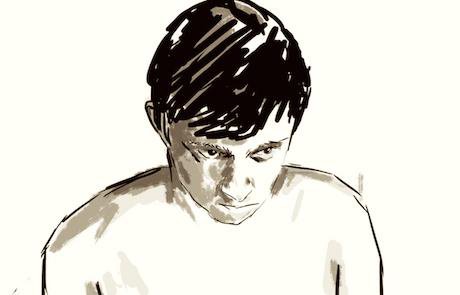
image by @ReeceWykes
Some 200 of the most vulnerable children in England and Wales are held in secure children’s homes. The law prohibits staff from using pain-inducing restraint on children inside the homes. But outside the homes, on visits to court, hospital or a family funeral, pain-inducing restraint is permitted for those children who are remanded or sentenced. What’s more, children can be locked into a “waist restraint belt”. In relation to immigration deportation, the prisons inspectorate has warned the waist restraint belt can be used like a “body belt”, the most extreme form of restraint available in prison, and very rarely used.
At the children’s rights charity Article 39, we aim to stop the authorisation of painful and unjustified restraint on vulnerable children. We’re seeking funds to mount a legal challenge against the Ministry of Justice.
Secure children’s homes are not the same as child prisons. Of the 200 children in secure children’s homes, about half are placed there for their own welfare and half sent by criminal courts.
The needs and backgrounds of children sent by the two different routes are virtually identical.
Youth Justice Board data shows that 40 per cent of children sent from criminal courts to secure children’s homes in 2014-16 were children in care. Nearly half (47%) were believed to have a learning disability or difficulty. The same proportion were said by council staff to be at risk of suicide or self-harm. And 17 per cent of the children were the subject of a local authority child protection plan, meaning action was already being taken to protect them from harm.
By anyone’s standards, children in secure children’s homes are extremely vulnerable.
The security company GeoAmey holds the Ministry of Justice contract to escort remanded and sentenced children to and from secure children’s homes. GeoAmey has, “a fleet of 30 vehicles designed specifically for the transportation of children and young people”, according to the company’s website.
Last year, the Youth Justice Board revealed in its annual report that the behaviour management system devised for child prisons is now used by its “secure escort contractor” taking children to and from secure children’s homes. This system includes techniques that deliberately inflict pain on children. A new form of restraint equipment — the “waist restraint belt” — has been added for the purposes of escorting.
Inflicting pain during restraint is banned inside children’s homes. Statutory guidance states: “Restraint that deliberately inflicts pain cannot be proportionate and should never be used on children in children’s homes.”
We wanted to know what the prison service’s independent medical advisor had told the government about the safety of restraint techniques used on detained children.
The response to our freedom of information request last September explained that the medical advisor had graded use of the techniques in different scenarios for likelihood of harm, and for the level of seriousness of potential harm.
Of 66 scenarios, 28 were rated as 2, on a scale of 1-5, for the risk of “death or permanent severe disability affecting everyday life”. If a child is subject to restraint with a “head hold”, the waist restraint belt carries this intolerable risk, we were told. Not surprisingly, the Home Office has banned the use of the waist restraint belt on pregnant detainees.
The Ministry of Justice told us at the same time that no child had suffered serious injury or breathing difficulties while under escort. But this doesn’t explain why the Ministry of Justice has authorised the use of pain during escort, when the Department for Education says such treatment can never be proportionate.
There is also the question of when restraint can be lawfully used on vulnerable children. The law allows escort officers to restrain children for “good order and discipline”, even though similar statutory rules were quashed by the Court of Appeal in 2008 as a breach of article 3 of the European Convention on Human Rights, protection from inhuman and degrading treatment or punishment. Staff working in children’s homes are not permitted to restrain children to make them follow orders.
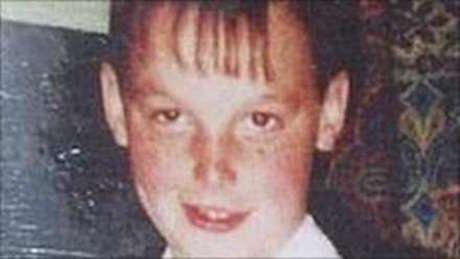
Adam Rickwood
The infliction of pain on children during restraint has proved lethal.
Fourteen year-old Adam Rickwood was remanded to a secure training centre run by Serco in Durham. There were no custodial places to begin with, so Adam was looked after in a children’s home where he settled well. Once imprisoned, his mental health severely deteriorated. He threatened to take his own life and wrote to the judge pleading for bail.
One Sunday, around a month after Adam arrived at the secure training centre, he was instructed to go to his cell because he had passed a note between two other children. The officer who read the note disapproved of its contents. Adam asked what he had done wrong and refused to leave the communal area. The restraint procedure was activated and four officers came running into the unit, grabbed hold of Adam and carried him, face down, into his cell. One of these four officers later conceded that Adam had been calm and had even tried to defuse the situation.
Adam struggled against the unlawful assault and was inflicted with a “nose distraction”, a restraint technique transferred from adult prisons. Officers would apply an “upward strike” to a child’s nose with the intention of causing severe pain. Adam’s nose bled for around an hour and his requests to go to hospital for an X-ray were ignored.
Hours later, Adam was found hanging in his cell.
Adam left behind a note for his lawyer explaining he had asked officers what gave them the right to hit a child in the nose, and they said it was restraint.
Adam died 13 years ago.
Since then authoritative experts and NGOs have expressed opposition to this form of restraint. They include the UN Committee Against Torture, the UN Committee on the Rights of the Child, the UN Human Rights Council, the parliamentary Joint Committee on Human Rights, Her Majesty’s Inspectorate of Prisons, the NSPCC and the UK’s four Children’s Commissioners.
Adam was not the only imprisoned child to die following restraint in 2004. Fifteen year-old Gareth Myatt was in a secure training centre in Northamptonshire run by G4S. He refused to clean a sandwich toaster because other children had also used it.
Gareth was ordered to his cell. He complied. Officers followed him and started removing his few possessions, including a piece of paper that had his mother’s new mobile phone number on it. Gareth was said to have raised his fist at this point.

Gareth Myatt
An officer “enveloped” Gareth who weighed just 6½ stone and stood less than five feet tall. Three officers then forced Gareth into a sitting position and bent his upper body towards his thighs and knees. They ignored his cries that he couldn’t breathe.
The terrifying ordeal lasted for six or seven minutes before Gareth lost consciousness.
This was his first time in custody. He had been sentenced on a Friday afternoon. By the following Monday evening he was dead.
The inquests, litigation, reviews and investigations which followed the deaths of Gareth and Adam brought into public view the reality of widespread unlawful restraint. The prison service was contracted to come up with a new system of behaviour management and restraint, and this was launched in 2012. It is called “Minimising and Managing Physical Restraint” (MMPR).
One-third of the restraint techniques within the MMPR system rely on the deliberate infliction of pain. The “nose distraction” that devastated Adam was replaced by the “mandibular angle technique”.
This involves officers applying pressure behind a child’s ear at the back of the jaw. We can try and piece together what is involved by reading the instructions to trainers that haven’t been redacted (crucial bits are blacked-out):
The instructors are told: “Emphasise staff can use finger or knuckle dependent on length of finger nails.” And: “Apply pressure inward and forward at a 45 degree angle.”
Last year BBC Panorama appeared to show a 14 year-old child, ‘Billy’, being subject to the mandibular angle technique at Medway secure training centre, which was then run by G4S. (It was later transferred to the prison service). Billy tells the officer he can’t breathe. Panorama asked Dr Andrew McDonnell, a clinical psychologist with expertise in reducing the use of restraint, to view the video clip. He said what was done to Billy was “really dangerous”.
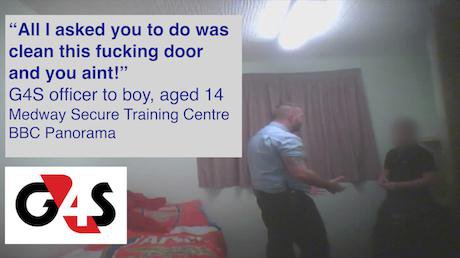
Screenshot, BBC Panorama, 'Teenage prison abuse exposed', January 2016
The mandibular angle technique features in the independent medical advisor’s assessment. When a child is standing (as Billy was) or being held down, this is also rated 2, on a scale of 1-5, for likelihood of causing death or permanent severe disability.
Adam and Gareth had both lived in children’s homes. Adam had hoped to move back to one. He kept his packed sports bag in the staff room so he could quickly leave the secure training centre once news of his bail arrived. He took his bag out of the staff room the day before he died, apparently resigned that a transfer to a children’s home was not going to happen.
As well as prohibiting pain, children’s homes’ statutory guidance says: “Children in residential child care should be loved, happy, healthy, safe from harm and able to develop, thrive and fulfil their potential.”
That statement is based upon centuries of learning about the needs of children, and conveys the respect we now give to children as human beings with dignity, feelings and rights. Our legal challenge seeks to uphold this commitment to children, from the moment they leave the court building.
As a small charity, Article 39 does not have the funds to bring this vital case. We need at least £8,000 to cover our application for a costs-capping order and to pay for unavoidable court fees and charges. And so we’re asking for help. If you can, please back our CrowdJustice appeal here, tell friends about our work, and share this link on social media.
- Edited by Clare Sambrook for Shine A Light at openDemocracy.
- @CLARESAMBROOK
- @SHINEreports
Read more
Get our weekly email

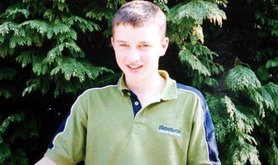
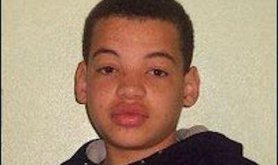
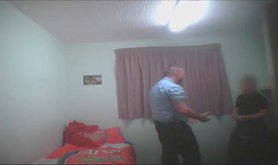

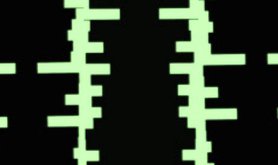


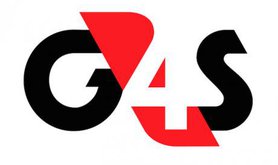


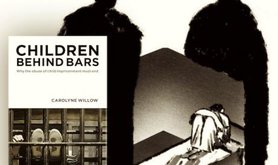
Comments
We encourage anyone to comment, please consult the oD commenting guidelines if you have any questions.